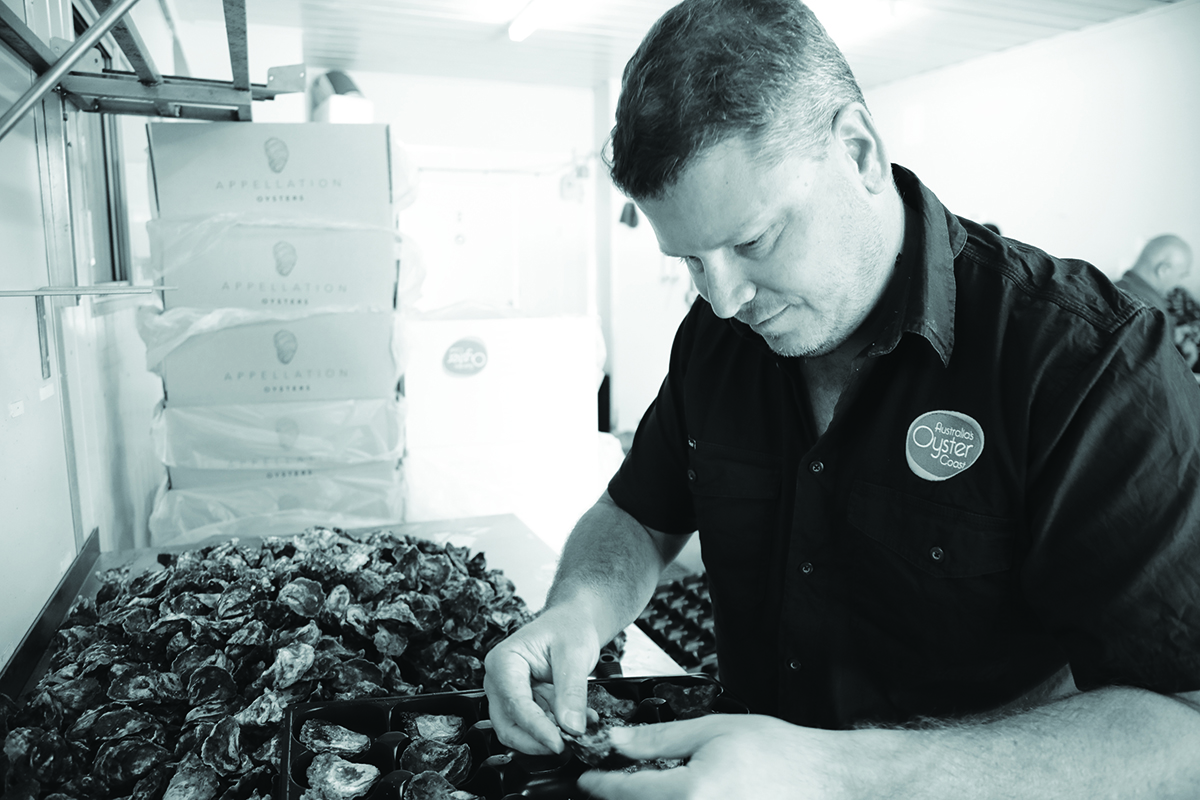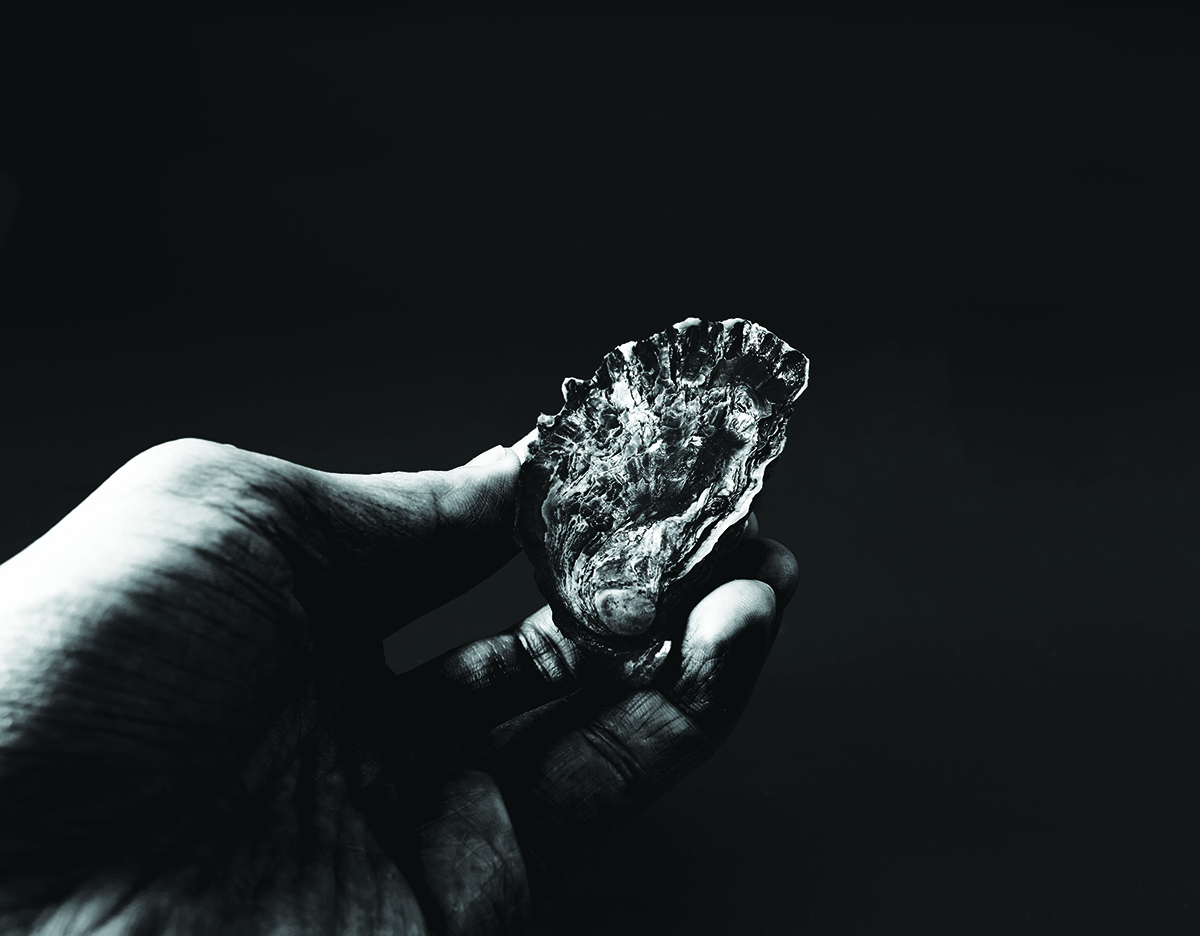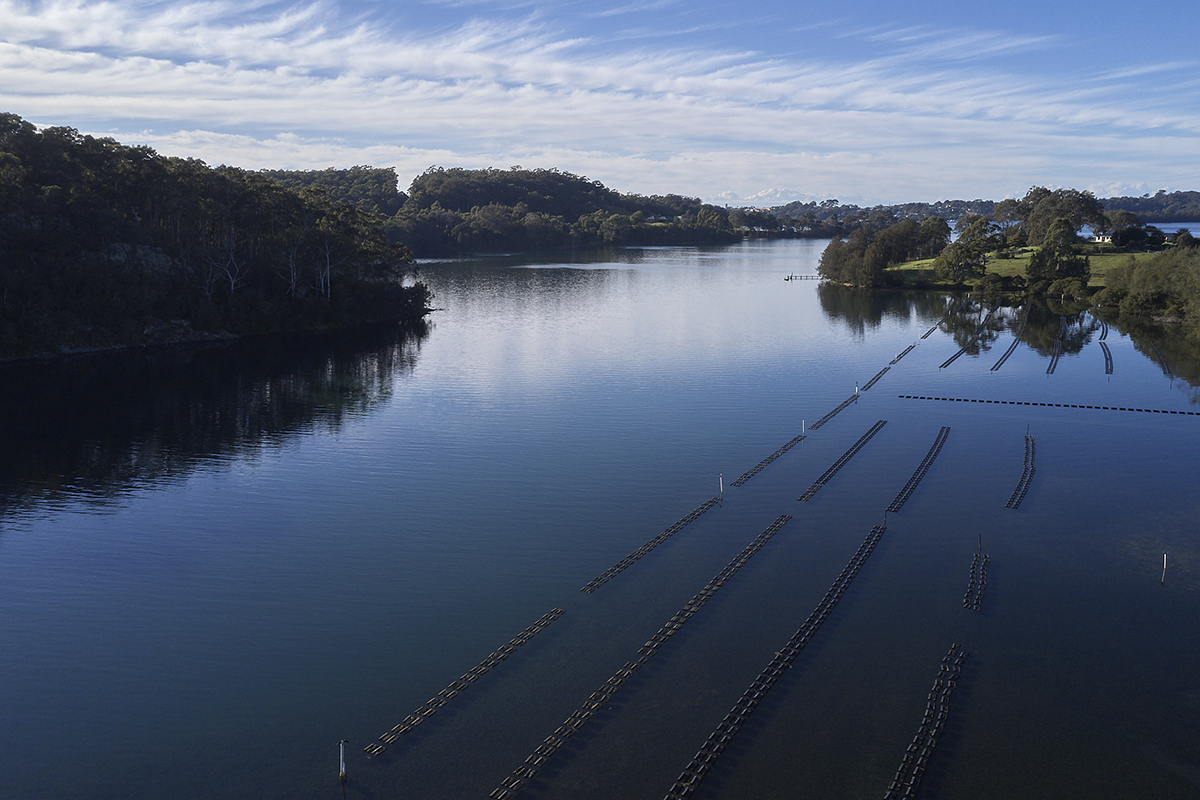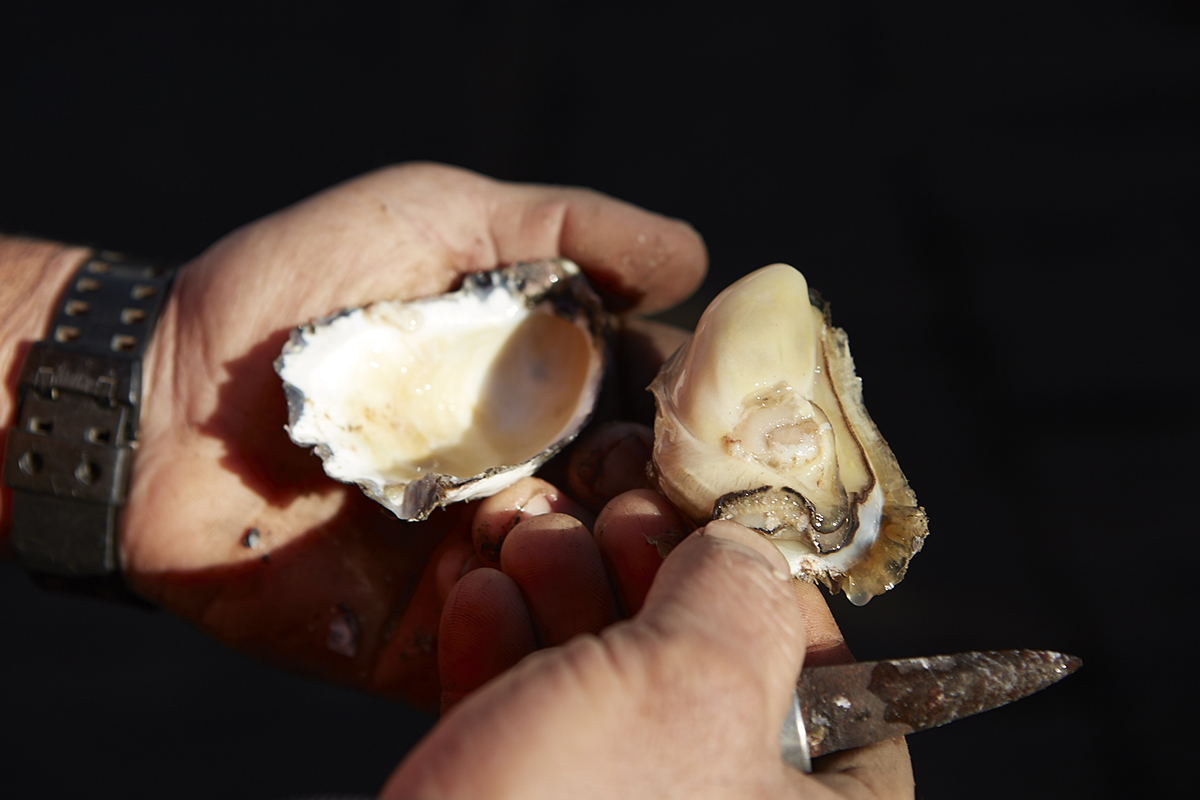
Meet The Oyster Sommelier
This so-called oyster sommelier is not only a man who can blind taste and immediately provide an accurate origin story, but someone central to sourcing and delivering the absolute ‘best in class’.
Related articles
They call him the ‘Oyster Whisperer’. He’s also known as the ‘Rock Oyster Sommelier’ and, more formally, CEO of Australia’s Oyster Coast. Introducing Mark Allsopp, a bona fide master with an ability to blind taste an oyster and not only tell you what estuary it was grown in, but what part of the estuary too.
Hardy, rugged and genetically wild – much like the magnificent and unique molluscs he shucks daily – Allsopp’s speciality is the rock oyster, commonly referred to as the ‘Sydney rock’.
Time now to make the French weep a few salty tears – because we Aussies really don’t appreciate that the ‘Sydney rock’ is in fact the envy of the global oyster community. With no familial ties anywhere else on the planet, it is genetically unique. It’s also geographically rare; endemic not just to Australia, but, in the main, to a 1500km stretch of NSW.
From Wooli Wooli, Macleay and Hastings Rivers, Wallis Lake, Port Stephens, Shoalhaven, Clyde River, Tuross, Wagonga, Wapengo, Merimbula, Pambula and Wonboyn, this is pure oyster heaven. And were this fine and finite crop champagne or caviar it would be priceless.
Allsopp understands this. And more. It’s why he’s behind an initiative to find the best-in-class rock oysters on any given day and award them what’s known as ‘Appellation status’.
Ahead of the summer season we decided to taste a few with Allsopp, to really get an understanding of what this heightened oyster business is all about.

You can read an oyster’s history by eating it – how did you hone your craft?
All I’ve done is link my understanding of the aquatic environment and the biology of the rock oyster, and how that translates to the flavour profile. There is some science, gastronomy and general oyster nerdiness involved, but it’s just time, patience and a love of oysters.
Why is the rock so special?
From a culinary perspective, it has a depth and complexity in flavour not seen in any other oyster on the planet. The gastronomic journey of a rock oyster is like going down the rabbit hole with Alice in Wonderland. The biology is fascinating. It thrives in an estuarine environment that would be to the detriment of most other oysters in the world. In fact, the tougher the environment, the better the oyster and eating experience.
Why do they vary from estuary to estuary?
A rock oyster is truly a product of its environment – constantly filtering the water to capture microscopic particles, then ingesting these particles. Every estuary has different environmental attributes, which we describe as merroir, ranging from salinity, micro-algae species, microbiota, biological organic matter, temperature, benthos substrate composition, terrestrial soil composition, sunlight, and many more. It’s the most variable environment on earth.

What the hell is merroir?
It’s the marine environment’s equivalent of terroir from the wine industry, which is the categorisation of flavours with environmental attributes. We know the marine environment is the most variable, and these different factors contribute to the overall aquatic ecosystem and this set of factors is synonymous with a flavour profile. For example, several estuaries have limited freshwater inputs and therefore are more influenced by oceanic tides; we call these ‘oceanic-influenced estuaries’ and we expect a strong brine experience front of palate and an intense mineralisation at the back.
And what’s an Appellation Oyster?
An Appellation Oyster is a best-in-class, hand-selected oyster. The people that handpick these oysters are looking for shape, size, maturity, meat condition and yield superior to an everyday oyster. If the oyster is good enough to be selected, it
is awarded Appellation status, placed in a box with an Appellation trust seal and sent to the restaurant.
What are you looking for when judging the best rock oysters?
Maturity. The feel of an oyster that has had two or three spawn cycles. It’s hard to explain because it’s not just weight or size, it’s a feel. Shell shape: deep cup, convex lid, and maybe some purple colouration on the bottom shell. Meat condition and yield: we want a beautiful khaki-coloured meat with at least 80% of the meat covering the bottom shell.

You’ve created the ‘five pitstops of flavour’ to describe how to best enjoy an oyster. Please explain.
This is the framework for anyone to understand the concept of merroir. The pitstops include brine, creaminess, sweetness, minerality and umami.
Brininess is determined by the salinity level of the estuary. If it’s oceanic influenced, the brine experience will be intense, meaning the concentration of salt in the water is high. Creaminess relates to the mouth feel – the creamier the oyster, the more progressed it is in its reproductive cycle. An oyster is 95% reproductive gland – similar to caviar – so to get a big creaminess we aim to harvest the oyster at the top of its reproductive cycle. Sweetness comes from its adductor muscle, which holds the top and bottom shell together. This muscle is intensely sweet and, like any muscle, the harder it works, the bigger it gets.
If the oyster has been living in an environment with significant wind and wave action, or if the farmer works the oysters, it’ll have to work hard to stay shut and the muscle will get bigger and sweeter. Rock oysters can also hold trace elements like zinc, copper and magnesium that come from the oceanic environment, and this mineralisation, or ‘zing’, literally comes from these elements sitting on your back palate and stimulating your taste receptors.
Umami, meanwhile, can come from the organic matter in the estuary. This can be in the form of floating organic matter from the terrestrial-environment run-off, or detritus [dead micro algae] on the benthos, or macroflora such as seaweed. When you experience this fifth pitstop, it is somewhat of a vegetal flavour.
Right – any tips for us simple folk wanting to really enjoy rock oysters this summer?
Let the oyster speak for itself – natural is the best experience. Try oysters from different regions and understand the merroir and corresponding flavour profile. Everyone thinks you have to have white wine with oysters – not true. Be creative – beer, sake and pinot noir all work well.
Appellation Oysters are available in the best restaurants in Australia – but you can also head straight to the source by travelling Australia’s Oyster Coast and tasting them at the farm gate yourself; appellationoysters.com
This piece is from our 2019 Summer Edition, to subscribe to the magazine, click here.
Subscribe to the Newsletter
Recommended for you
The Ultimate Guide to Pairing Wine With Spicy Food
What to drink when your favorite cuisine brings the heat.
Up Close and Personal
From Saudi princes to cashed-up entrepreneurs, private chefs are now highly prized—for their cooking prowess and undying commitment. But can they keep a secret?
March 28, 2024
You may also like.
You may also like.
Watch of the Week: TAG Heuer Formula 1 | Kith
The legendary sports watch returns, but with an unexpected twist.
Over the last few years, watch pundits have predicted the return of the eccentric TAG Heuer Formula 1, in some shape or form. It was all but confirmed when TAG Heuer’s heritage director, Nicholas Biebuyck, teased a slew of vintage models on his Instagram account in the aftermath of last year’s Watches & Wonders 2023 in Geneva. And when speaking with Frédéric Arnault at last year’s trade fair, the former CEO asked me directly if the brand were to relaunch its legacy Formula 1 collection, loved by collectors globally, how should they go about it?
My answer to the baited entreaty definitely didn’t mention a collaboration with Ronnie Fieg of Kith, one of the world’s biggest streetwear fashion labels. Still, here we are: the TAG Heuer Formula 1 is officially back and as colourful as ever.
As the watch industry enters its hype era—in recent years, we’ve seen MoonSwatches, Scuba Fifty Fathoms, and John Mayer G-Shocks—the new Formula 1 x Kith collaboration might be the coolest yet.

Here’s the lowdown: overnight, TAG Heuer, together with Kith, took to socials to unveil a special, limited-edition collection of Formula 1 timepieces, inspired by the original collection from the 1980s. There are 10 new watches, all limited, with some designed on a stainless steel bracelet and some on an upgraded rubber strap; both options nod to the originals.
Seven are exclusive to Kith and its global stores (New York, Los Angeles, Miami, Hawaii, Tokyo, Toronto, and Paris, to be specific), and are made in an abundance of colours. Two are exclusive to TAG Heuer; and one is “shared” between TAG Heuer and Kith—this is a highlight of the collection, in our opinion. A faithful play on the original composite quartz watch from 1986, this model, limited to just 1,350 pieces globally, features the classic black bezel with red accents, a stainless steel bracelet, and that creamy eggshell dial, in all of its vintage-inspired glory. There’s no doubt that this particular model will present as pure nostalgia for those old enough to remember when the original TAG Heuer Formula 1 made its debut.

Of course, throughout the collection, Fieg’s design cues are punctuated: the “TAG” is replaced with “Kith,” forming a contentious new brand name for this specific release, as well as Kith’s slogan, “Just Us.”
Collectors and purists alike will appreciate the dedication to the original Formula 1 collection: features like the 35mm Arnite cases—sourced from the original 80s-era supplier—the form hour hand, a triangle with a dot inside at 12 o’clock, indices that alternate every quarter between shields and dots, and a contrasting minuterie, are all welcomed design specs that make this collaboration so great.
Every TAG Heuer Formula 1 | Kith timepiece will be presented in an eye-catching box that complements the fun and colour theme of Formula 1 but drives home the premium status of this collaboration. On that note, at $2,200 a piece, this isn’t exactly an approachable quartz watch but reflects the exclusive nature of Fieg’s Kith brand and the pieces he designs (largely limited-edition).

So, what do we think? It’s important not to understate the significance of the arrival of the TAG Heuer Formula 1 in 1986, in what would prove integral in setting up the brand for success throughout the 90’s—it was the very first watch collection to have “TAG Heuer” branding, after all—but also in helping to establish a new generation of watch consumer. Like Fieg, many millennial enthusiasts will recall their sentimental ties with the Formula 1, often their first timepiece in their horological journey.
This is as faithful of a reissue as we’ll get from TAG Heuer right now, and budding watch fans should be pleased with the result. To TAG Heuer’s credit, a great deal of research has gone into perfecting and replicating this iconic collection’s proportions, materials, and aesthetic for the modern-day consumer. Sure, it would have been nice to see a full lume dial, a distinguishing feature on some of the original pieces—why this wasn’t done is lost on me—and perhaps a more approachable price point, but there’s no doubt these will become an instant hit in the days to come.
—
The TAG Heuer Formula 1 | Kith collection will be available on Friday, May 3rd, exclusively in-store at select TAG Heuer and Kith locations in Miami, and available starting Monday, May 6th, at select TAG Heuer boutiques, all Kith shops, and online at Kith.com. To see the full collection, visit tagheuer.com
You may also like.
8 Fascinating Facts You Didn’t Know About Aston Martin
The British sports car company is most famous as the vehicle of choice for James Bond, but Aston Martin has an interesting history beyond 007.
Aston Martin will forever be associated with James Bond, ever since everyone’s favourite spy took delivery of his signature silver DB5 in the 1964 film Goldfinger. But there’s a lot more to the history of this famed British sports car brand beyond its association with the fictional British Secret Service agent.
Let’s dive into the long and colourful history of Aston Martin.
You may also like.
What Venice’s New Tourist Tax Means for Your Next Trip
The Italian city will now charge visitors an entry fee during peak season.
Visiting the Floating City just got a bit more expensive.
Venice is officially the first metropolis in the world to start implementing a day-trip fee in an effort to help the Italian hot spot combat overtourism during peak season, The Associated Press reported. The new program, which went into effect, requires travellers to cough up roughly €5 (about $AUD8.50) per person before they can explore the city’s canals and historic sites. Back in January, Venice also announced that starting in June, it would cap the size of tourist groups to 25 people and prohibit loudspeakers in the city centre and the islands of Murano, Burano, and Torcello.
“We need to find a new balance between the tourists and residents,’ Simone Venturini, the city’s top tourism official, told AP News. “We need to safeguard the spaces of the residents, of course, and we need to discourage the arrival of day-trippers on some particular days.”
During this trial phase, the fee only applies to the 29 days deemed the busiest—between April 25 and July 14—and tickets will remain valid from 8:30 am to 4 pm. Visitors under 14 years of age will be allowed in free of charge in addition to guests with hotel reservations. However, the latter must apply online beforehand to request an exemption. Day-trippers can also pre-pay for tickets online via the city’s official tourism site or snap them up in person at the Santa Lucia train station.
“With courage and great humility, we are introducing this system because we want to give a future to Venice and leave this heritage of humanity to future generations,” Venice Mayor Luigi Brugnaro said in a statement on X (formerly known as Twitter) regarding the city’s much-talked-about entry fee.
Despite the mayor’s backing, it’s apparent that residents weren’t totally pleased with the program. The regulation led to protests and riots outside of the train station, The Independent reported. “We are against this measure because it will do nothing to stop overtourism,” resident Cristina Romieri told the outlet. “Moreover, it is such a complex regulation with so many exceptions that it will also be difficult to enforce it.”
While Venice is the first city to carry out the new day-tripper fee, several other European locales have introduced or raised tourist taxes to fend off large crowds and boost the local economy. Most recently, Barcelona increased its city-wide tourist tax. Similarly, you’ll have to pay an extra “climate crisis resilience” tax if you plan on visiting Greece that will fund the country’s disaster recovery projects.
You may also like.
Omega Reveals a New Speedmaster Ahead of the Paris 2024 Olympics
Your first look at the new Speedmaster Chronoscope, designed in the colour theme of the Paris Olympics.
The starters are on the blocks, and with less than 100 days to go until the Paris 2024 Olympics, luxury Swiss watchmaker Omega was bound to release something spectacular to mark its bragging rights as the official timekeeper for the Summer Games. Enter the new 43mm Speedmaster Chronoscope, available in new colourways—gold, black, and white—in line with the colour theme of the Olympic Games in Paris this July.
So, what do we get in this nicely-wrapped, Olympics-inspired package? Technically, there are four new podium-worthy iterations of the iconic Speedmaster.

The new versions present handsomely in stainless steel or 18K Moonshine Gold—the brand’s proprietary yellow gold known for its enduring shine. The steel version has an anodised aluminium bezel and a stainless steel bracelet or vintage-inspired perforated leather strap. The Moonshine Gold iteration boasts a ceramic bezel; it will most likely appease Speedy collectors, particularly those with an affinity for Omega’s long-standing role as stewards of the Olympic Games.
Notably, each watch bears an attractive white opaline dial; the background to three dark grey timing scales in a 1940s “snail” design. Of course, this Speedmaster Chronoscope is special in its own right. For the most part, the overall look of the Speedmaster has remained true to its 1957 origins. This Speedmaster, however, adopts Omega’s Chronoscope design from 2021, including the storied tachymeter scale, along with a telemeter, and pulsometer scale—essentially, three different measurements on the wrist.
While the technical nature of this timepiece won’t interest some, others will revel in its theatrics. Turn over each timepiece, and instead of a transparent crystal caseback, there is a stamped medallion featuring a mirror-polished Paris 2024 logo, along with “Paris 2024” and the Olympic Rings—a subtle nod to this year’s games.
Powering this Olympiad offering—and ensuring the greatest level of accuracy—is the Co-Axial Master Chronometer Calibre 9908 and 9909, certified by METAS.

A Speedmaster to commemorate the Olympic Games was as sure a bet as Mondo Deplantis winning gold in the men’s pole vault—especially after Omega revealed its Olympic-edition Seamaster Diver 300m “Paris 2024” last year—but they delivered a great addition to the legacy collection, without gimmickry.
However, the all-gold Speedmaster is 85K at the top end of the scale, which is a lot of money for a watch of this stature. By comparison, the immaculate Speedmaster Moonshine gold with a sun-brushed green PVD “step” dial is 15K cheaper, albeit without the Chronoscope complications.
—
The Omega Speedmaster Chronoscope in stainless steel with a leather strap is priced at $15,725; stainless steel with steel bracelet at $16,275; 18k Moonshine Gold on leather strap $54,325; and 18k Moonshine Gold with matching gold bracelet $85,350, available at Omega boutiques now.
Discover the collection here
You may also like.
Here’s What Goes Into Making Jay-Z’s $1,800 Champagne
We put Armand de Brignac Blanc de Noirs Assemblage No. 4 under the microsope.
In our quest to locate the most exclusive and exciting wines for our readers, we usually ask the question, “How many bottles of this were made?” Often, we get a general response based on an annual average, although many Champagne houses simply respond, “We do not wish to communicate our quantities.” As far as we’re concerned, that’s pretty much like pleading the Fifth on the witness stand; yes, you’re not incriminating yourself, but anyone paying attention knows you’re probably guilty of something. In the case of some Champagne houses, that something is making a whole lot of bottles—millions of them—while creating an illusion of rarity.
We received the exact opposite reply regarding Armand de Brignac Blanc de Noirs Assemblage No. 4. Yasmin Allen, the company’s president and CEO, told us only 7,328 bottles would be released of this Pinot Noir offering. It’s good to know that with a sticker price of around $1,800, it’s highly limited, but it still makes one wonder what’s so exceptional about it.
Known by its nickname, Ace of Spades, for its distinctive and decorative metallic packaging, Armand de Brignac is owned by Louis Vuitton Moët Hennessy and Jay-Z and is produced by Champagne Cattier. Each bottle of Assemblage No. 4 is numbered; a small plate on the back reads “Assemblage Four, [X,XXX]/7,328, Disgorged: 20 April, 2023.” Prior to disgorgement, it spent seven years in the bottle on lees after primary fermentation mostly in stainless steel with a small amount in concrete. That’s the longest of the house’s Champagnes spent on the lees, but Allen says the winemaking team tasted along the way and would have disgorged earlier than planned if they’d felt the time was right.
Chef de cave, Alexandre Cattier, says the wine is sourced from some of the best Premier and Grand Cru Pinot Noir–producing villages in the Champagne region, including Chigny-les-Roses, Verzenay, Rilly-la-Montagne, Verzy, Ludes, Mailly-Champagne, and Ville-sur-Arce in the Aube département. This is considered a multi-vintage expression, using wine from a consecutive trio of vintages—2013, 2014, and 2015—to create an “intense and rich” blend. Seventy percent of the offering is from 2015 (hailed as one of the finest vintages in recent memory), with 15 percent each from the other two years.

This precisely crafted Champagne uses only the tête de cuvée juice, a highly selective extraction process. As Allen points out, “the winemakers solely take the first and freshest portion of the gentle cuvée grape press,” which assures that the finished wine will be the highest quality. Armand de Brignac used grapes from various sites and three different vintages so the final product would reflect the house signature style. This is the fourth release in a series that began with Assemblage No. 1. “Testing different levels of intensity of aromas with the balance of red and dark fruits has been a guiding principle between the Blanc de Noirs that followed,” Allen explains.
The CEO recommends allowing the Assemblage No. 4 to linger in your glass for a while, telling us, “Your palette will go on a journey, evolving from one incredible aroma to the next as the wine warms in your glass where it will open up to an extraordinary length.” We found it to have a gorgeous bouquet of raspberry and Mission fig with hints of river rock; as it opened, notes of toasted almond and just-baked brioche became noticeable. With striking acidity and a vein of minerality, it has luscious nectarine, passion fruit, candied orange peel, and red plum flavors with touches of beeswax and a whiff of baking spices on the enduring finish. We enjoyed our bottle with a roast chicken rubbed with butter and herbes de Provence and savored the final, extremely rare sip with a bit of Stilton. Unfortunately, the pairing possibilities are not infinite with this release; there are only 7,327 more ways to enjoy yours.


























